LEARNING GOAL
Summarize prenatal development.
LEARNING GOAL
Summarize prenatal development.
Developmental psychology explores how all of us grow across the phases of our lives, from conception through infancy, childhood, adolescence, and adulthood. These changes result from both nature (our genetics and biology) and nurture (the environment around us). Together, nature and nurture influence growth in three developmental areas: physical, socio-emotional, and cognitive (Figure 4.1).
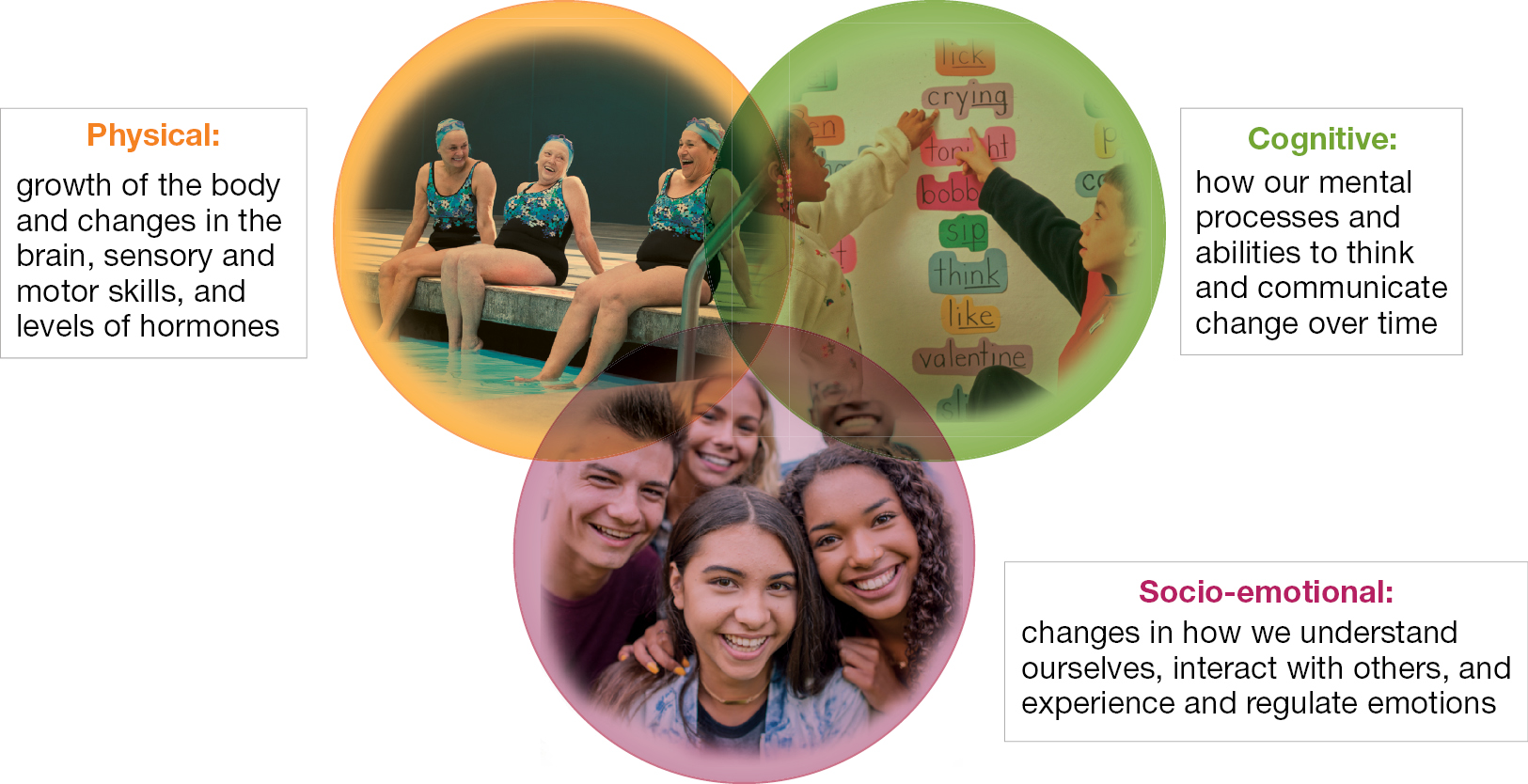
Three photos within bubbles describe the physical, cognitive, and socio-emotional changes one goes through in life. The bubble labeled Physical depicts three women in swimsuits sitting by a pool; the caption reads, growth of the body and changes in the brain, sensory and motor skills, and levels of hormones. The bubble labeled Cognitive depicts two children pointing to words on a bulletin board; the caption reads, how our mental processes and abilities to think and communicate change over time. The bubble labeled Socio-emotional depicts three women dancing; the caption reads, changes in how we understand ourselves, interact with others, and experience and regulate emotions.
FIGURE 4.1 Interactions Between Three Areas of Development
Humans develop in three areas: physical, socio-emotional, and cognitive. Change in each area affects and is affected by change in other areas.
Physical changes involve shifts in hormone levels, growth of the body, and changes in the brain. Socio-emotional changes include changes in how we understand ourselves, interact with others, and experience and regulate emotions. Cognitive changes relate to how we think, reason, and communicate. These changes include how you function at school, so take time to review the IMPACT strategy of Improving in the Learning to Learn figure on page 137. Throughout life, nature and nurture influence our development in all three of these areas. You began life as just one cell in the uterus (also called the womb), and about 40 weeks later you were born. Human prenatal development is development that takes place before birth, and it includes three major periods of physical growth: the germinal period, the embryonic period, and the fetal period (Figure 4.2).
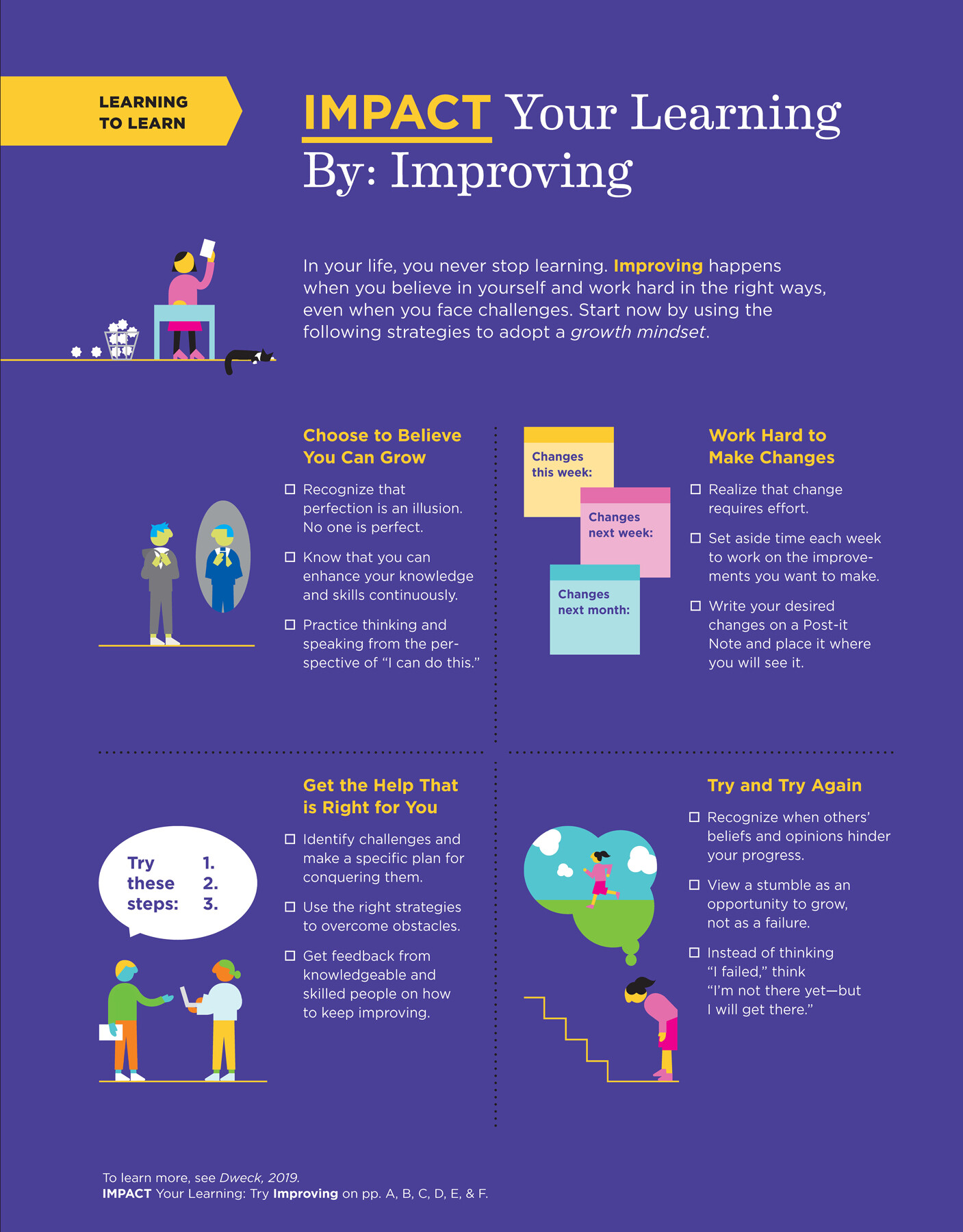
Five illustrations are present on the page. The first illustration shows a girl standing at a table with her hands lifted and holding a sheet of paper. A small basket is present near the table with lots of paper bundles. An adjacent text reads, In your life, you never stop learning. Improving happens when you believe in yourself and work hard in the right ways, even when you face challenges. Start now by using the following strategies to adopt a growth mindset. The second illustration shows a man looking at himself in a mirror. The colors of the dress in the real image and mirror image are different. An adjacent text reads, Choose to Believe You Can Grow. Recognize that perfection is an illusion. No one is perfect. Know that you can enhance your knowledge and skills continuously. Practice thinking and speaking from the perspective of “I can do this.” The third illustration resembles three sticky notes with the following text: Changes this week, Changes next week, and Changes next month. An adjacent text reads, Work Hard to Make Changes. Realize that change requires effort. Set aside time each week to work on the improvements you want to make. Write your desired changes on a Post-it Note and place it where you will see it. The fourth illustration shows two people conversing in which one has a book or a sheet of paper in his hand while the other holds a laptop. A call out near them reads Try these steps 1, 2, 3. The fifth illustration shows a person standing exhausted before climbing stairs. A call-out shows this person running on a green field. An adjacent text reads Try and Try Again. Recognize when others’ beliefs and opinions hinder your progress. View a stumble as an opportunity to grow, not as a failure. Instead of thinking “I failed,” think “I’m not there yet - but I will get there.”
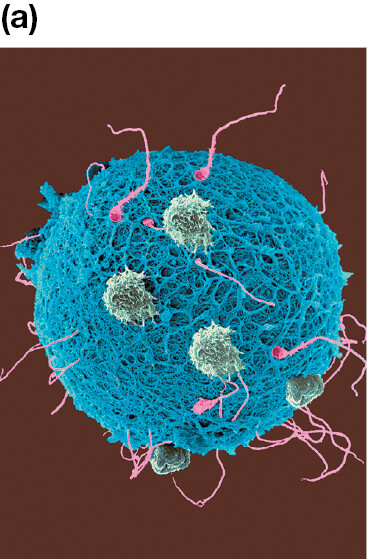
The egg is stained bright blue in this micrograph and is almost perfectly circular. There are around 10 bright pink sperm cells with long flagella glommed onto the sides. There are 4 white balls stuck into the egg.

The skin is translucent and there is a large black dot inside the head and a brown dot in the stomach area. There is a massive amount of pink tissue surrounding the fetus.
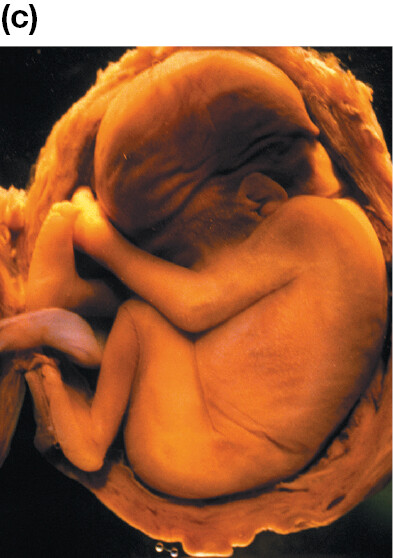
FIGURE 4.2 Prenatal Development
(a) In the germinal period, the union of egg and sperm forms a zygote that implants in the wall of the uterus by the end of two weeks. (b) In the embryonic period, from the start of week 3 through week 8, the organs develop in the embryo. (c) The fetal period, from the start of week 9 until birth, is a time of tremendous physical growth and brain development that prepares the baby to survive outside the womb.
Germinal Period The germinal period begins with conception, when the sperm from the male unites with the egg from the female. This union creates the zygote, the first cell of a new life. The zygote begins to divide rapidly into two cells, then four cells, then eight cells, and so on (Figure 4.2a). Within two weeks after fertilization, implantation of the zygote occurs in the wall of the uterus, and the placenta begins to form in order to nourish the developing human. If any abnormalities occur during this earliest stage of development, the result is usually a miscarriage before the woman even knows she is pregnant.
Embryonic Period From about the start of week 3 to the end of week 8, the developing human is known as an embryo (Figure 4.2b). The embryonic period is the most important time for physical development of the spinal cord, brain, and all internal organs, including the heart, lungs, liver, kidneys, and sex organs (Figure 4.3). If development goes wrong, birth defects may result, and miscarriage remains a threat. For example, if the mother has not consumed enough of the nutrient folic acid during the first month of prenatal development, then the embryo’s spinal cord and brain may not develop properly. If the embryo then survives, the baby may be born with serious birth defects such as spina bifida, which includes an abnormally formed spine. For this reason, women who want to become pregnant are encouraged to eat foods such as spinach, broccoli, citrus fruits, beans, and avocados, which contain folic acid, or to take prenatal vitamins containing folic acid (Figure 4.4).
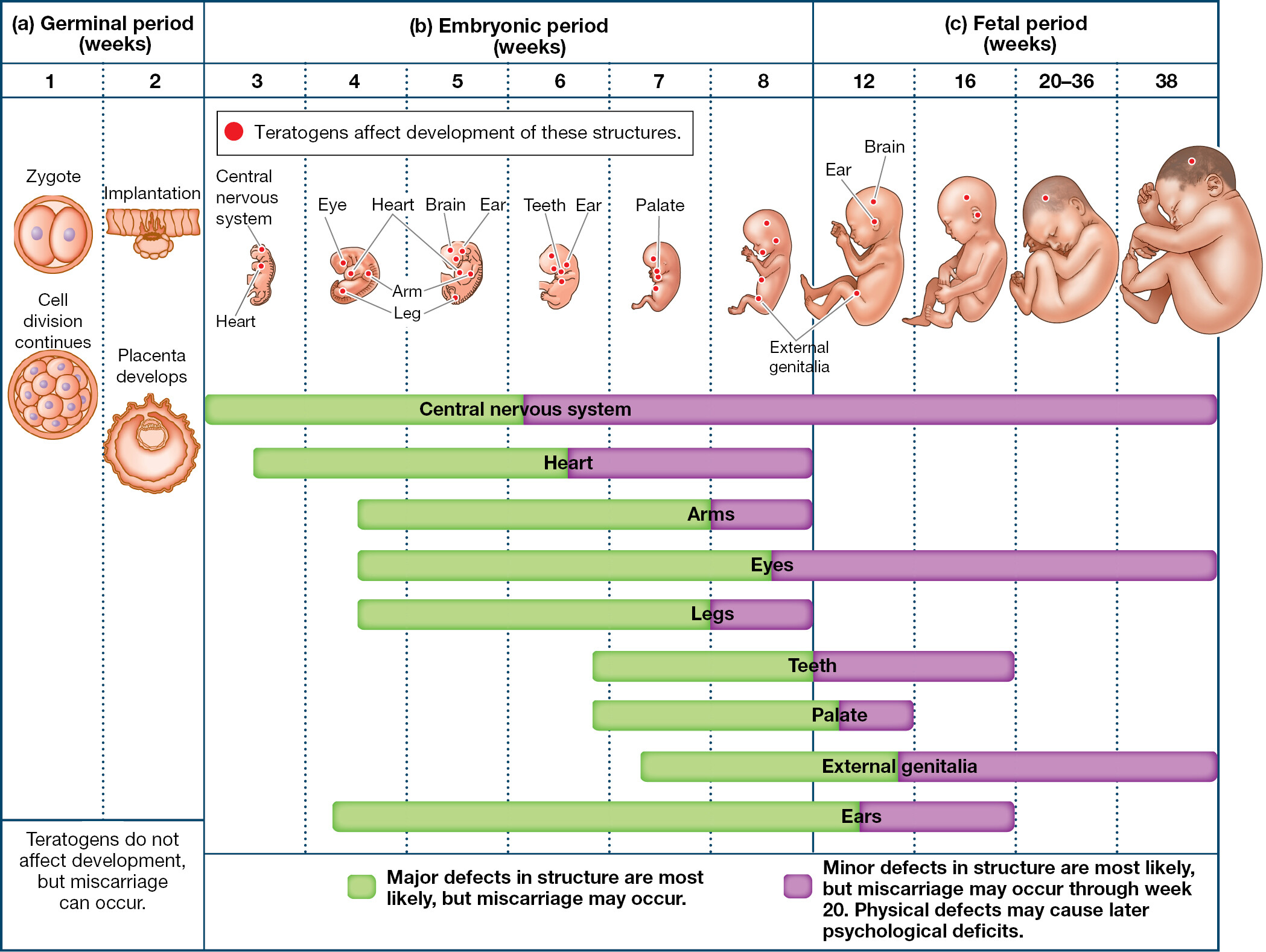
A complex infographic and chart on the physical changes in the germinal, embryonic, and fetal periods. The chart contains three columns and their headers are Germinal period (weeks), Embryonic period (weeks), and Fetal period (weeks). The germinal period occurs in the first and second weeks. Four pictures are showing the physical development during this period. The first two pictures in week one show a fertilized egg (labeled as a zygote) and then an image depicting more cell divisions occurring within the fertilized egg. The next two images are in week two. They depict the fertilized egg attaching to the wall of the uterus and the development of the placenta. The caption at the bottom of the germinal period says, Teratogens do not affect development here, but miscarriage can occur. The embryonic stage is next and occurs during week three through week eight. There are six pictures with red dots on the embryo for each week during this period. The red dots represent teratogens which are defined as any agent that can affect the development of an embryo or fetus. Week three shows teratogens affecting the central nervous system and heart. Week four shows them affecting the heart, arms, legs, and eyes. Week five shows them affecting the brain, ears, heart, legs, and arms. Week six shows them affecting the teeth, heart, brain, and ears. Week seven shows them affecting the heart, brain, arms, and palate. Week eight shows them affecting the brain, ears, palate, heart, and external genitalia. The fetal period occurs from week twelve to week thirty-eight. There are four fetuses in different stages of development representing weeks during the fetal period. The teratogens affect the external genitalia, ear, and brain during week twelve. Week sixteen shows them affecting the brain and ears. Weeks twenty through thirty-eight show teratogens affecting the brain. Below the pictures for the embryonic and fetal periods are bars for each body part made of two different colors. The green part shows when there can be major defects in the structure, while the purple part shows when there can be psychological defects and minor defects in the structure. For the central nervous system, the green period is from week three to week five and the purple period is from week six to week thirty-eight. For the heart, the green period is from week 3.5 to 6.5 and the purple period is from week 6.5 to eight. For the arms, the green period is from week 4.5 to eight and the purple period is from week eight to twelve. For the eyes, the green period is from week 4.5 to 8.5 and the purple period is from week 8.5 to thirty-eight. For the legs, the green period is from week 4.5 to eight and the purple period is from week eight to twelve. For the teeth, the green period is from week 6.9 to twelve and the purple period is from week twelve to twenty. For the palate, the green period is from week 6.9 to 12.3 and the purple period is from week 12.3 to sixteen. For the external genitalia, the green period is from week 7.3 to 12.7 and the purple period is from week 12.7 to thirty-eight. For the ears, the green period is from week 4.2 to 12.4 and the purple period is from week 12.4 to twenty.
FIGURE 4.3 Physical Changes in the Three Prenatal Periods
(a) The germinal period starts when the sperm meets the egg. Problems during this period usually result in miscarriage. (b) The internal organs develop during the embryonic period, when differences in development may result in major or minor physical defects in bodily structures. (c) In the fetal period, the organs start to function. Developmental differences in the fetal period are primarily related to minor physical defects in structures. Problems in physical development at any point in the prenatal period may result in psychological deficits after birth. During which period is the heart most susceptible to developing defects?

FIGURE 4.4 The Importance of Folic Acid
Nutritional deficiencies can cause serious birth defects. This mom-to-be is doing the right thing. Eating dark leafy greens, such as spinach, can help her baby’s spine and brain develop.
Fetal Period From the start of week 9 until birth, the growing human is called a fetus (Figure 4.2c). During this fetal period, no new structures develop, but birth defects remain possible, and miscarriage remains a threat through week 20. The fetus’s whole body continues to change physically (Figure 4.3c). For example, at about 16 weeks the fetus begins to move its muscles. A first-time mother might feel these movements by about 20 weeks. The eyes and eyelids finish developing at 6 months. The organs also finish developing, allowing the infant, once it is born, to breathe on its own and digest the food it eats. In the last 12 weeks of prenatal growth, the fetus develops fat under its skin and increases dramatically in length and weight. While the fetus is growing larger, its brain also matures. The brain begins to process sensory input and motor output.
Problems in physical development at any point during the prenatal period may affect psychological development after birth, possibly leading to deficits in cognitive, emotional, or social functioning.
Most healthy full-term pregnancies end with the birth of the baby 38 to 42 weeks after conception. However, the fetus is thought to be fully developed and able to live outside of the womb at 28 weeks of gestation. Modern medical technology has made it possible for a fetus to live outside the womb much earlier in its development. About half of infants born at 25 weeks of gestation survive, and up to 10 percent of fetuses born at 22 weeks of gestation now survive outside the womb. For example, Amillia Sonja Taylor was born in 2006, after spending just 21 weeks and 6 days in the womb.
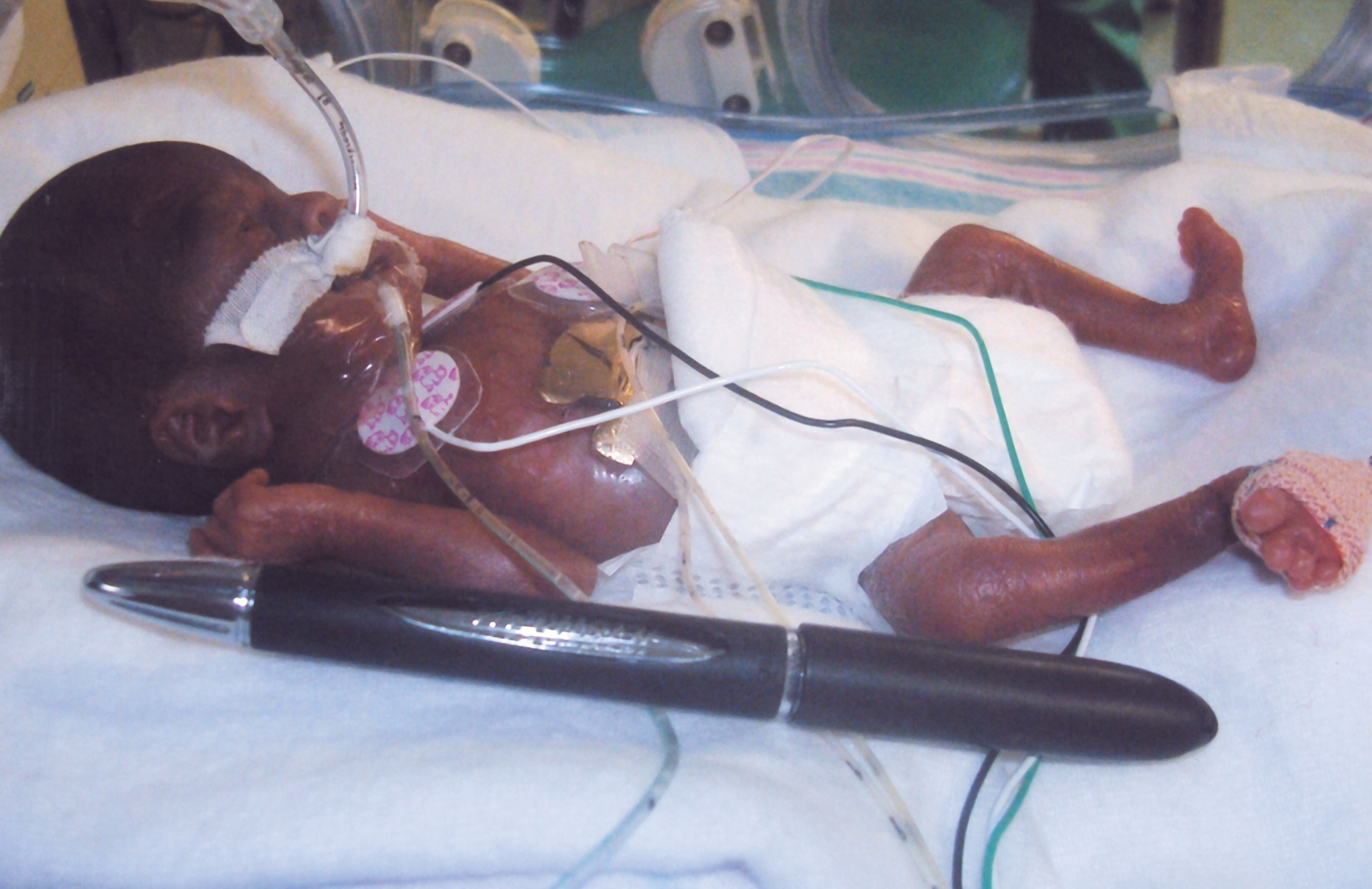
FIGURE 4.5 A Case of Extreme Prematurity
At birth, Amillia Sonja Taylor was a little longer than a ballpoint pen, and she weighed 10 ounces—less than the weight of a can of soda. Today she is a healthy child.
We do not always know what causes premature birth, although it is likely that genetics, nutrition, and environment all play roles. Clear risk factors for premature birth are parental smoking, drinking, and drug use. Babies who are born prematurely have a greater risk of dying as infants. They also may have disabilities, such as cerebral palsy, breathing and feeding problems, and vision and hearing deficits. In addition, prematurity can have long-term effects on intellectual development, school performance, and even adult social relationships (Jansen et al., 2020; Wolke et al., 2019). But prematurity does not always lead to negative outcomes. After a rough start, baby Amillia (shown shortly after birth in Figure 4.5) is now a healthy and successful child.
LEARNING GOAL CHECK: REVIEW